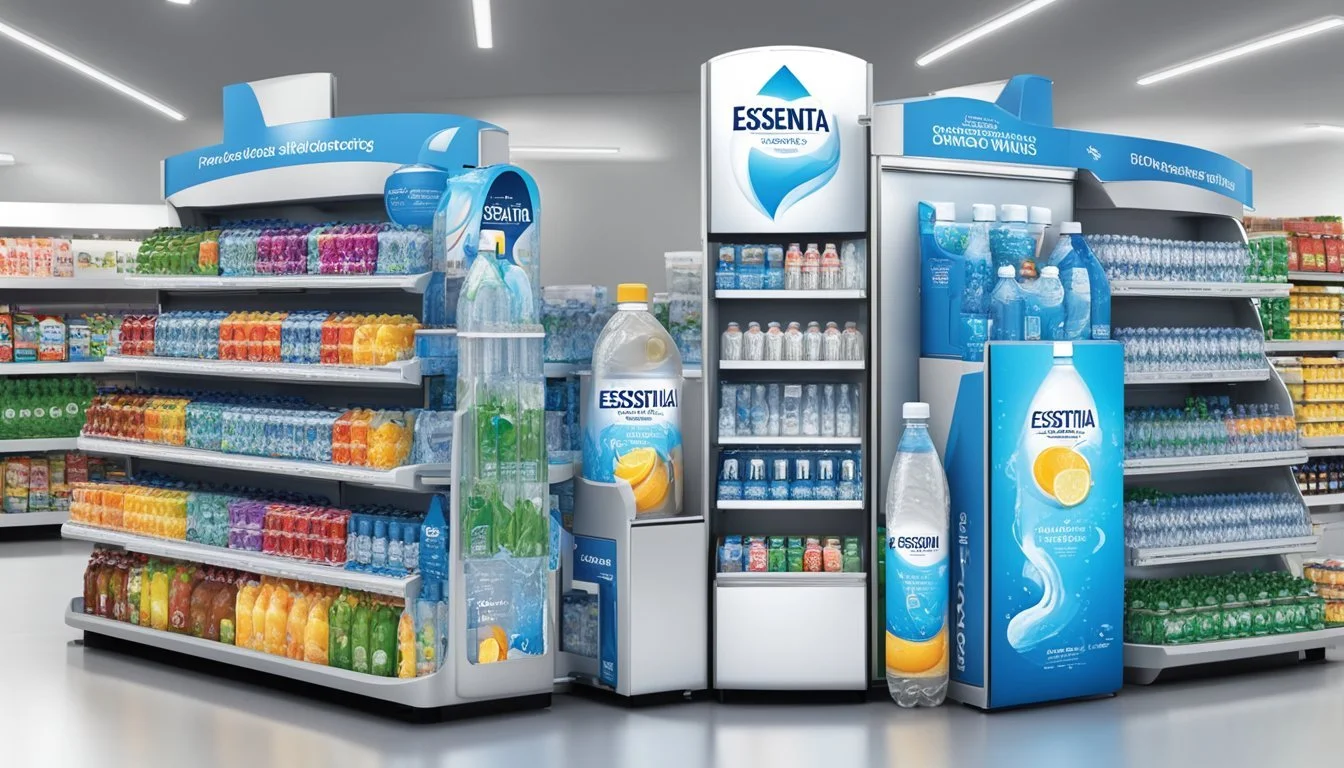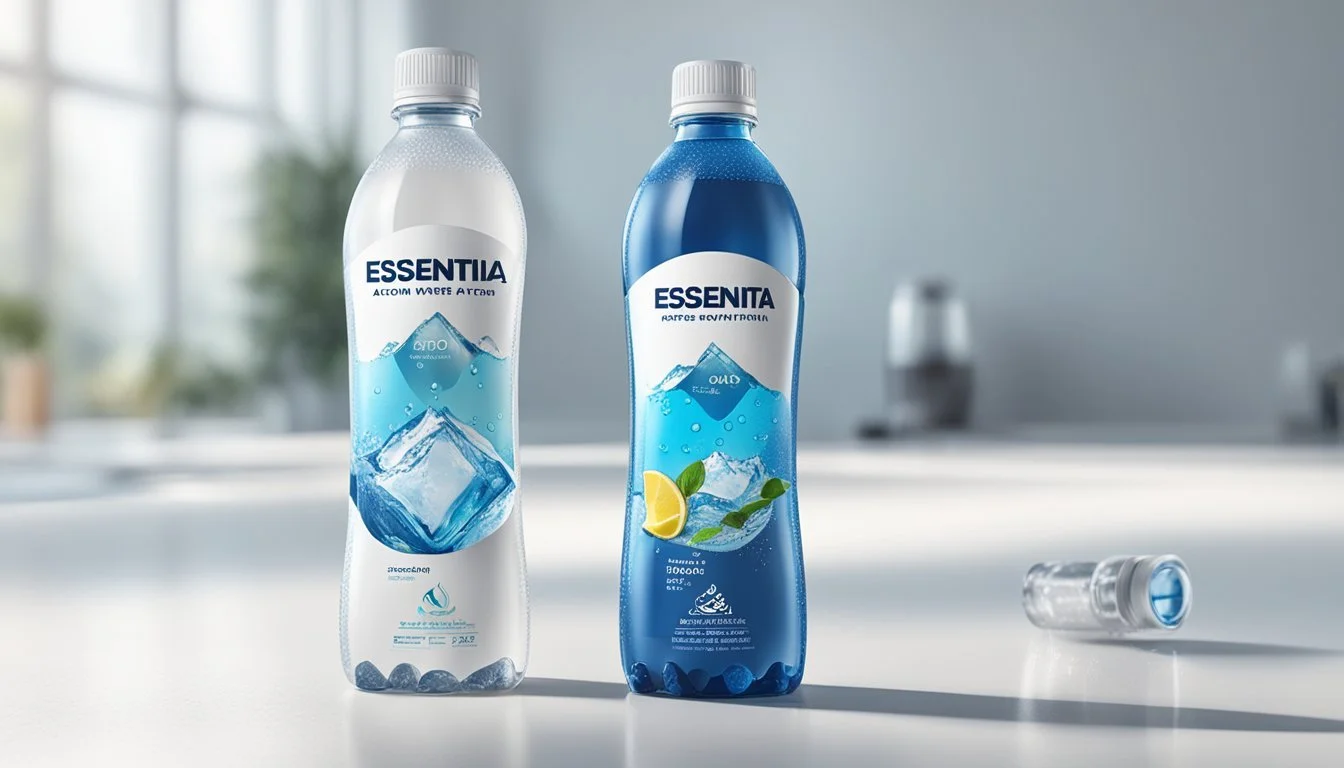Essentia vs. Action
Which Bottled Water is Better for Hydration?
When choosing bottled water, many consumers prioritize quality, taste, and health benefits. Essentia and Action are two prominent brands that cater to these preferences. Essentia claims to offer water with a high pH level and added electrolytes, aimed at boosting hydration and overall wellness. In contrast, Action focuses on purity and the absence of contaminants, marketing itself as a clean, refreshing choice.
Essentia emerges as a leader for those seeking alkaline water with enhanced hydration properties. Its purification process, involving micro-filters and reverse osmosis, ensures a 99.9% purity level, while maintaining a high pH of 9.5 or above. This makes it appealing for individuals looking to balance their body's acidity and improve hydration.
On the other hand, Action emphasizes a straightforward, clean taste without any additives. Action's commitment to purity can be attractive to consumers who prefer their water in its most natural state. By understanding the unique benefits and qualities of each brand, readers can make an informed decision on which bottled water best meets their needs.
Understanding Bottled Water
Bottled water comes in various types and origins, each with unique characteristics that influence its quality, taste, and health benefits. Knowing the source and quality is key to making informed choices.
Types of Bottled Water
There are several types of bottled water available on the market, each distinguished by its source and treatment process.
Spring Water
Spring water originates from natural springs where water flows to the surface. It is often rich in natural minerals, which can enhance its taste and health benefits.
Mineral Water
Mineral water is sourced from mineral springs and contains a defined level of minerals such as calcium, magnesium, and sodium. These minerals are naturally dissolved in the water and are beneficial for health.
Purified Water
Purified water undergoes processes like distillation, reverse osmosis, or deionization to remove impurities. This type of water is often free from contaminants but lacks the minerals found in spring or mineral water.
Sparkling Water
Sparkling water contains dissolved carbon dioxide gas, either naturally occurring or added during bottling. It offers a fizzy sensation and can be sourced from springs or created by carbonation of purified water.
Distilled Water
Distilled water is produced by boiling water and then condensing the steam back into a liquid. This process removes minerals and impurities, making it one of the purest forms of bottled water, often used in medical and industrial applications.
Source and Quality
The source of bottled water greatly influences its quality and taste.
Natural Sources
Water sourced from natural springs or wells typically retains minerals that contribute to its taste and health benefits. These sources are often considered pure and are subject to fewer treatments.
Treatment Processes
The quality of bottled water is also determined by the purification methods used. Processes like microfiltration, reverse osmosis, and ultraviolet light treatment ensure safety and purity by removing harmful substances.
Mineral Content
Mineral content varies depending on the source. High mineral content can offer additional health benefits, making mineral and spring water popular choices for those seeking natural hydration solutions.
Plastic Bottles and Health
The packaging of bottled water is another crucial aspect. Plastic bottles, often made from PET, can sometimes release substances like BPA, posing potential health risks. Consumers are increasingly opting for BPA-free bottles to avoid these issues.
Understanding these aspects helps in selecting the right type of bottled water that suits individual needs and preferences.
Health and Safety Considerations
Choosing between Essentia and Action bottled water involves examining their health impacts and safety compliance. Critical areas include the levels of contaminants and adherence to safety standards set by regulatory bodies.
Contaminant Levels
Essentia water is known for its high pH, typically over 9.5, indicating low acidity. It undergoes ionization, which raises its pH and purifies the water. This process removes contaminants such as heavy metals and reduces total dissolved solids (TDS).
Action bottled water should be evaluated for similar factors. It is essential to check if the water meets Environmental Protection Agency (EPA) guidelines for contaminants. Regular testing for lead, BPA, and other harmful substances is crucial.
Essentia:
High pH (over 9.5)
Ionized for purification
Low TDS
Safety Standards
Both Essentia and Action must comply with safety standards enforced by authorities like the EPA. This includes testing for a variety of contaminants and ensuring water quality stability. Essentia's ionization process is geared toward meeting and exceeding these standards, offering added peace of mind regarding its safety.
Action bottled water's safety standards should be similarly scrutinized. Ensuring compliance with EPA regulations and regular testing are fundamental. The use of BPA-free packaging and maintaining low levels of heavy metals are significant factors for consumer health and wellness.
Essentia:
Meets EPA guidelines
BPA-free packaging
Low heavy metals
Chemical Profile
Essentia and Action bottled waters vary significantly in their chemical makeup, particularly in their pH levels and electrolyte infusions. These differences can affect taste, hydration benefits, and overall suitability for consumers with specific health concerns.
pH and Alkalinity
Essentia water is known for its high pH level, typically around 9.5, which positions it as one of the more alkaline options available. The high pH is achieved through a process that includes micro-filtration, reverse osmosis, and ionization. These methods reduce contaminants while increasing the water’s alkalinity.
Action water, on the other hand, generally has a lower pH level, closer to neutral, ranging from 6 to 7. This makes it less alkaline compared to Essentia. The lower pH level can be more appealing to those who prefer a taste closer to regular tap water. Alkaline water like Essentia’s is often marketed for its potential benefits in neutralizing acid in the bloodstream and improving hydration.
Electrolyte Infusion
Essentia water contains a blend of potassium bicarbonate, sodium bicarbonate, and other electrolytes such as calcium and magnesium. These minerals are added to improve taste and enhance hydration by replenishing electrolytes lost during physical activities. The infusion process also ensures consistent taste and quality across different batches.
Action water may also include electrolytes, but the specific types and concentrations are less prominently advertised compared to Essentia. Lower electrolyte content can be a deciding factor for athletes or individuals looking for more robust hydration solutions. Consumers interested in detailed mineral content should review the labels for specifics like amounts of calcium, magnesium, and potassium bicarbonate in each brand.
By reviewing these aspects, users can make more informed choices based on their hydration needs and flavor preferences.
Brands: Essentia and Action Comparison
Essentia and Action are two prominent brands in the premium bottled water market. This section will compare their company profiles and product differentiation, providing a clear and detailed look at each brand's unique attributes.
Company Profiles
Essentia Water Essentia, a pioneer in the ionized alkaline water segment, is well-known for its high pH level of 9.5 or higher. This brand focuses on offering ionized alkaline water that promotes better hydration. Essentia's water is filtered to 99.9% purity using a meticulous process involving micro-filtration, reverse osmosis, and ultraviolet exposure.
Action Water (Hypothetical) Action is a competitor in the premium water market. It targets consumers by emphasizing natural purity and sustainable sourcing. Although it doesn't specifically market ionized alkaline water, Action ensures its water is free from contaminants and additives. The brand appeals to eco-conscious consumers with its minimal environmental impact.
Product Differentiation
Essentia Water Essentia distinguishes itself through ionized alkaline water with a high pH level, promoting improved hydration and balance. The water undergoes a specific ionization process, infusing it with electrolytes. Essentia prides itself on transparency, allowing consumers to know exactly what's in their water, which involves enhanced purity and added minerals.
Action Water Action highlights natural purity and sustainability. Unlike Essentia, it does not ionize its water or focus on pH levels. Instead, it offers water that is naturally alkaline and free from synthetic additives. Action appeals to consumers who prioritize environmental stewardship, emphasizing sustainable practices in sourcing and packaging.
In summary, Essentia focuses on scientifically enhanced, ionized alkaline water with a high pH, while Action emphasizes natural purity and sustainability without additional processing.
Purification and Enhancement Processes
Essentia and Action employ distinct methods to purify and enhance their bottled water. They combine techniques such as reverse osmosis and ionization to ensure high quality and health benefits.
Reverse Osmosis Explained
Essentia's purification begins with reverse osmosis. This technique forces water through a semi-permeable membrane, effectively removing impurities, bacteria, and dissolved solids. Microfiltration is often a preliminary step, filtering out larger particles before reverse osmosis further purifies the water.
Action also uses reverse osmosis, ensuring their water reaches a high level of purity. This process results in water that is over 99% free of contaminants. The technology behind reverse osmosis is critical because it dramatically reduces pollutants, providing a clean base for further enhancements.
Subsequent Ionization
Essentia follows up with an ionization process. This involves adding electrolytes such as calcium, magnesium, and potassium. These minerals not only improve the taste but also offer health benefits. Ultraviolet exposure ensures the elimination of any remaining microorganisms, making the water safe and clean.
Action, while focusing on purity, also enhances their water post-purification. They use a similar method of adding essential minerals back into the purified water. This enhancement aims to balance the pH levels and boost hydration efficiency. Each stage of their purification process is designed to maximize quality while ensuring the water retains a fresh and appealing taste.
Taste and Hydration
Choices in bottled water often hinge on factors like taste and hydration capabilities. Understanding how these elements influence user preference and performance can help make an informed decision.
The Science of Taste
Taste plays a crucial role in bottled water selection. Essentia water, known for its high pH level of 9.5, offers a unique alkaline taste that some find refreshing. The ionization process incorporated by Essentia adds a slightly crisp flavor to the water.
Action Water, in comparison, often targets a neutral pH closer to 7, aligning with typical drinking water. This creates a clean taste that appeals to those who prefer less mineralized flavor profiles. Other factors such as added electrolytes can enhance flavor subtlety and appeal, contributing to superior taste for some individuals.
Hydration and Performance
Hydration is another key factor where bottled water brands compete. Essentia’s high pH level aims to help with faster and more efficient hydration, potentially beneficial for athletic performance. The brand's proprietary mineral blend and ionization are engineered to enhance hydration effects.
Action Water may not focus as much on pH levels but often includes essential electrolytes, aiding hydration post-exercise. Electrolytes like potassium and magnesium are crucial for maintaining hydration during physical activities. While some claim Essentia's alkalinity neutralizes acid in the bloodstream, others appreciate Action's added electrolytes for their immediate hydration benefits.
Both brands cater to varied hydration needs, impacting user performance based on personal taste preferences and hydration effectiveness.
Environmental Impacts and Sustainability
When comparing Essentia and Action bottled water, it is crucial to evaluate the environmental impacts resulting from their production and packaging processes, as well as the efforts each brand makes towards sustainability.
Bottling and Packaging
The production of plastic bottles is a significant factor in assessing environmental impact. Essentia uses polyethylene terephthalate (PET) for its bottles, a material that is recyclable but contributes to pollution if not properly managed. The environmental concerns associated with PET include the production-related carbon emissions and potential for BPA (bisphenol A) exposure, although many brands market their bottles as BPA-free to mitigate health risks.
Action bottled water seems dedicated to using eco-friendly materials. They reportedly focus on reducing plastic waste by promoting reusable bottle options and exploring plant-based materials for packaging. The production process for such alternatives typically results in lower carbon emissions and minimal environmental pollution compared to traditional plastic bottles.
Brand Responsibility
Both Essentia and Action are aware of their environmental footprint and have strategies to address sustainability issues. Essentia has taken steps to implement recycling initiatives and support environmental programs aimed at reducing plastic waste. The brand also emphasizes the use of BPA-free materials, which can be beneficial for consumer safety and the environment.
Action, on the other hand, highlights its commitment to sustainability by engaging in environmental advocacy and investing in research to develop innovative, eco-friendly packaging solutions. This includes collaborations with environmental organizations to promote clean water initiatives and reduce overall plastic use.
By focusing on these sustainability measures, Essentia and Action take important steps towards mitigating their environmental impact and promoting a more sustainable future.
Benefits for Active Lifestyles
Both Essentia and Action water provide various benefits that can support active lifestyles, including nutritional advantages and enhancements to physical and mental well-being.
Nutritional Advantages
Essentia water boasts a higher pH level, typically around 9.5, which aligns with an alkaline diet. Its composition includes added electrolytes like calcium, magnesium, and potassium.
These elements can help replenish lost minerals during strenuous physical activity. Action water, known for its purity and natural mineral content, focuses on providing a balanced intake without altering water through artificial means. This can support hydration without introducing unnecessary additives.
For individuals engaged in regular exercise or intense workouts, these nutritional aspects are crucial. Electrolyte balance plays a significant role in maintaining hydration levels, regulating muscle function, and promoting recovery post-exercise.
Physical and Mental Benefits
High-pH water like Essentia may offer rapid hydration which is beneficial during and after workouts. Fast hydration helps in preventing cramps and sustaining energy levels throughout physical activities. Essentia and Action water also potentially aid in maintaining mental clarity by keeping dehydration at bay.
Proper hydration can influence cognitive function, enhancing focus and reaction times, which is valuable in sports and everyday activities. Additionally, Action water's natural minerals can contribute to a steady, long-term hydration source, supporting not just physical performance but also everyday mental tasks.
Both brands, hence, focus on reinforcing healthy habits among active individuals by ensuring the water they consume aids in recovery and overall performance enhancement.
Market Presence and Availability
Essentia and Action water brands have distinct market strategies affecting their availability and pricing. This section will delve into how accessible these brands are to consumers and what price points they typically occupy.
Consumer Accessibility
Essentia water enjoys widespread availability, being sold through major grocery stores, Amazon, and other online retailers. Its presence in physical retail locations like Walmart and Target ensures easy access for most consumers. Action water, while not as ubiquitous, can be found in select stores and online platforms such as Boxed and Amazon.
Essentia is commonly found alongside other premium brands like Fiji Water, Voss, and Core Hydration. In contrast, Action often appears in more specialized health and wellness stores. SmartWater, Dasani, and Aquafina maintain presence in more widespread retail chains, making them more accessible to the general public.
Product Pricing
Essentia positions itself in the premium segment, with prices reflecting its ionized alkaline features and high pH level. Typically, a 1-liter bottle of Essentia costs between $1.50 and $2.00. In comparison, Action water is marketed slightly lower, making it a more budget-friendly choice while still maintaining quality.
Essentia's pricing strategy is aligned with other high-end brands like Evian and Fiji, which command similar price points. In contrast, Nestle Pure Life and Arrowhead are more affordable, appealing to a broader audience. Meanwhile, LIFEWTR and SmartWater position themselves in mid-tier pricing, balancing affordability and quality.
Essentia justified its higher price through its marketing emphasizing hydration benefits and alkaline content, which resonates with health-conscious consumers. Action manages to attract budget-minded buyers who seek quality without the premium price tag, making it a viable option for a different segment of the market.
Comparative Analysis
Essentia and Action are two popular bottled water brands, each with unique qualities. Comparative effectiveness and value for money are key factors to consider when choosing between these two options.
Product Effectiveness
Essentia water is highly regarded for its high pH level, often over 9.5, which classifies it as alkaline. This alkalinity may appeal to those seeking health benefits such as better hydration or acid reduction.
It undergoes a comprehensive purification process:
Micro-filtration: Removes impurities.
Reverse osmosis: Ensures 99.9% purity.
Ultraviolet exposure: Kills bacteria.
Essentia also infuses electrolytes, enhancing taste and hydration.
In comparison, Action water highlights its advanced distillation method that removes a wide range of contaminants. Distilled water often has a lower Total Dissolved Solids (TDS) count, indicating higher purity but may lack electrolytes and minerals. Consumers may favor distilled water for its cleanliness but miss out on the additional benefits of electrolytes present in alkaline water like Essentia.
Value for Money
When considering cost, Essentia may be more expensive due to its extensive purification process and added electrolytes. The price reflects its high pH and the perceived health benefits associated with alkaline water.
Essentia:
Cost: Higher
Added benefits: Electrolytes, high pH level.
Action:
Cost: Generally lower.
Purity focus: Distilled, low TDS.
The higher cost of Essentia may be justified for those seeking its specific hydrating benefits, while Action provides a more budget-friendly option focusing on purity. Consumers should weigh these factors based on their personal preferences and nutritional priorities before making a purchase decision.
More About Essentia
Essentia vs Cascade Mountain: Which Bottled Water is Better?
Essentia vs Hawaiian Springs: Which Bottled Water is Better?
Essentia vs Icelandic Glacial: Which Bottled Water is Better?
Essentia vs Kirkland Signature: Which Bottled Water is Better?
Essentia vs Mountain Valley Spring Water: Which Bottled Water is Better?
Essentia vs Nestle Pure Life: Which Bottled Water is Better?
Essentia vs Richard's Rainwater: Which Bottled Water is Better?
Essentia vs Talking Rain AQA: Which Bottled Water is Better?
Essentia vs Whole Foods Italian Still Mineral water: Which Bottled Water is Better?








